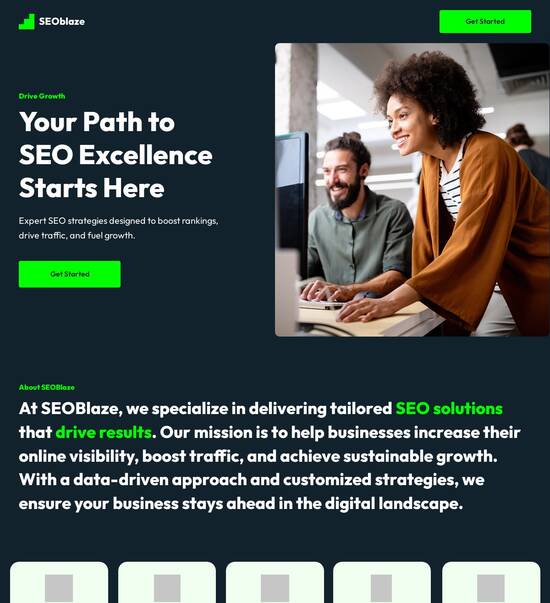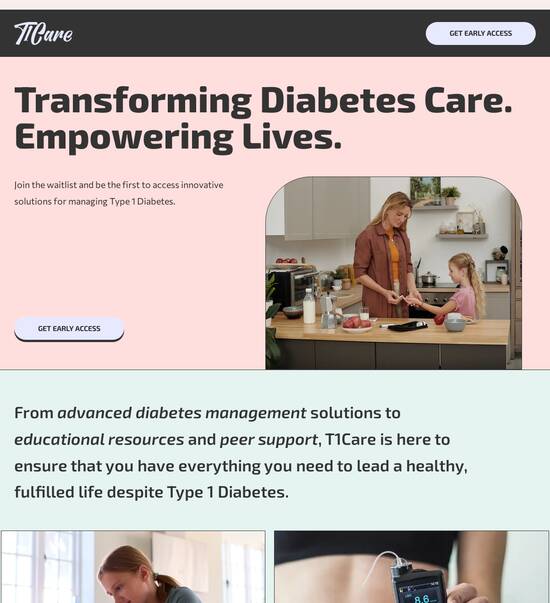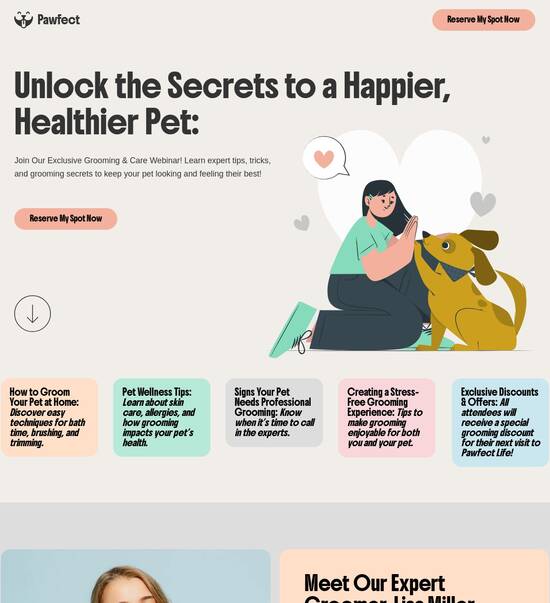
One Page Website Template for Bike Stores
Explore Similar TemplatesAbout template
Create a stunning and high-converting single page website for your bike store with Instapage's easy-to-use template. No coding required, just pick from our library of conversion-focused layouts and start driving more sales and traffic to your business.
Recommended templates

Easy to build without coding
With the intuitive drag-and-drop builder, anyone on your team can create high-converting pages without any knowledge of code or design. Make enhancements to your landing page with custom widgets using Javascript, HTML/CSS, or third-party scripts.

Multiple layouts for any industry and goal
Select from 500+ landing page layouts built to boost conversions across industry-specific scenarios. Customize them by adjusting fonts, adding images, and generating on-brand content with the AI assistant. Quickly scale with Instablocks® and Global Blocks that you can save, reuse, and update globally.

Loads fast and looks polished on any device
Every template is responsive, which means they present professionally on any device and load blazingly fast with our Thor Render Engine. You can also power them up with Google AMP technology to deliver an unparalleled mobile experience and drive higher conversions.

Robust analytics & experimentation
Get real-time updates and reporting across all your devices, showing the number of visitors, conversions, cost-per-visitor, and cost-per-lead. Launch AI-powered experiments, run A/B tests, and use heatmaps to analyze user behavior, then optimize your landing page to maximize conversions.







Easy to build without coding
With the intuitive drag-and-drop builder, anyone on your team can create high-converting pages without any knowledge of code or design. Make enhancements to your landing page with custom widgets using Javascript, HTML/CSS, or third-party scripts.
Multiple layouts for any industry and goal
Select from 500+ landing page layouts built to boost conversions across industry-specific scenarios. Customize them by adjusting fonts, adding images, and generating on-brand content with the AI assistant. Quickly scale with Instablocks® and Global Blocks that you can save, reuse, and update globally.
Loads fast and looks polished on any device
Every template is responsive, which means they present professionally on any device and load blazingly fast with our Thor Render Engine.
Robust analytics & experimentation
Get real-time updates and reporting across all your devices, showing the number of visitors, conversions, cost-per-visitor, and cost-per-lead. Launch AI-powered experiments, run A/B tests, and use heatmaps to analyze user behavior, then optimize your landing page to maximize conversions.
All the features you need to build lead-generating landing pages
Explore more featuresLearn how to build top-performing landing pages for any goal
FAQs
Leading the way in building high-performing landing pages





Accelerate your marketing with Instapage landing page templates
Instapage's landing page templates are designed to help marketers in various sectors such as tech, education, and business services to launch high-converting campaigns. With over 100 ready-to-use options and powerful lead generation elements, Instapage enables you to craft visually striking and conversion-focused pages tailored to your audience's needs and expectations.
Benefits of using landing page templates
Landing page templates streamline your design efforts, allowing you to focus on your strategy and messaging. Here are a few key benefits:
- Quick deployment: Templates help you launch campaigns faster, minimizing time spent on design.
- Proven performance: Utilize pre-tested layouts that have shown higher conversion rates.
- Customization options: Easily adjust templates to align with your brand and messaging.
Step 1: Choose the right template for your goals
Identifying the right template can significantly impact your campaign's success. Follow these steps:
- Assess your target audience: Choose designs that resonate with your marketing vertical, such as Tech/SaaS or Financial Services.
- Define your campaign objectives: Select templates tailored for lead generation, sales, or event registration.
- Review template features: Ensure the chosen template includes elements like forms, CTAs, and social proof.
Step 2: Customize to enhance engagement
After selecting a template, customization is key to making your landing page truly yours. Focus on these areas:
- Branding elements: Add your logo, colors, and fonts to maintain brand consistency.
- Dynamic content: Utilize Instapage’s personalization features to tailor messages for different audience segments.
- SEO optimization: Include relevant keywords in headings and body text for better search rankings.
Step 3: Optimize for conversion
An optimized landing page can greatly increase your conversion rates. Implement the following strategies:
- A/B testing: Experiment with different headlines, images, and copy to find the best performing version.
- Analytics tools: Use heatmaps and conversion tracking to understand user behavior and tweak accordingly.
- Mobile responsiveness: Ensure your page is optimized for mobile users, as a significant portion of traffic this way.
By following these steps, marketers can exploit the full potential of Instapage templates to drive results.
Ready to elevate your campaigns? Start using Instapage's powerful landing page templates today and experience exponential growth in your marketing ROI.
People also ask about One page website template for bike stores
One page website template for bike stores
The evolution of bike store websites: A shift to simplicity and functionality
Over the years, traditional bike store websites have seen numerous updates and iterations. Typically, these multi-page sites offered a plethora of features, such as detailed product listings, information about services, blogs, and contact pages. While they provided ample information, the extensive navigation often led to confusion and frustration among users. A cluttered user interface could detract from the shopping experience, making it difficult for potential customers to find what they were looking for. Additionally, many of these websites struggled with accessibility, leaving some users behind due to complicated layouts.
The rise of one-page websites marks a significant departure from traditional designs. One-page layouts offer a seamless browsing experience where all critical information is displayed on a single scrollable page. These templates are characterized by their aesthetic simplicity and focus, making it easier for users to navigate. The alignment of content and streamlined design not only enhances user experience but also addresses various accessibility concerns, encouraging more engagement from visitors.
Crafting the ultimate one page website template for bike stores
Building a one-page website for bike stores that is not only attractive but functional is essential. One of the key components is a responsive design. As mobile usage continues to skyrocket, a responsive website ensures that users have an optimal viewing experience whether they are on a desktop, tablet, or smartphone. This adaptability caters to a wide audience and improves overall user satisfaction.
Ensure the website hero section draws immediate attention, featuring captivating images of bikes.
Incorporate a product catalog that showcases the range of bikes and accessories available.
Include a shopping cart and checkout section to facilitate e-commerce capabilities seamlessly.
Moreover, integrating contact forms will allow for customer interaction. Engaging with customers through feedback forms or inquiries fosters a sense of community and trust. For an effective one-page website, it is vital to create social proof by displaying customer reviews and testimonials, which can significantly influence purchasing decisions.
Unpacking the functionality: Key elements of the template
Streamlined navigation is critical for keeping users engaged on a one-page website. Techniques such as anchor links for smooth scrolling, along with sticky headers that remain visible as one browses, provide a user-friendly experience. This method of navigation allows users to quickly find what they are looking for, enhancing the overall efficiency of the browsing experience.
Additionally, visual hierarchy plays an essential role in user experience design. Utilizing techniques like bold headings, clear typography, and distinct layout styles will help prioritize content visibility. Organizing elements based on their importance allows users to process information quickly, thus enhancing the user experience.
Leveraging document.addeventlistener for enhanced interactivity
JavaScript plays a pivotal role in enhancing interactivity on one-page websites. The `document.addeventlistener` functionality enables developers to track user engagement through various actions. Monitoring clicks and transitions directly contributes to understanding user behavior, allowing store owners to optimize their site further according to preferences.
Implementing interactive elements is also crucial for keeping visitors engaged. Adding features like image sliders and video embeds creates a visually stimulating experience. These elements can showcase the latest bikes or highlight promotional content, keeping customers informed and intrigued.
Maximizing impact during DOM content loaded
The speed of the website is paramount, especially when loading a one-page design. The term DOMContentLoaded refers to the point at which the initial HTML document has been completely loaded and parsed. Recognizing its significance can help enhance user experience, as faster loading pages generally lead to lower bounce rates.
Best practices for loading assets are also necessary to achieve peak performance. Incorporating techniques such as lazy loading for images will only load elements when they come into the viewport, thereby improving time to load significantly. Additionally, deferring JavaScript can contribute further to streamlined performance by enhancing page speed.
Visual and thematic considerations for bike shops
Designing a one-page website for a bike shop must reflect the unique brand identity of the business. Color schemes should be carefully selected to create feelings associated with cycling, such as freedom and adventure. Aesthetic choices can establish mood; therefore, understanding the target audience and incorporating their preferences is essential.
Moreover, utilizing high-quality, engaging visuals is crucial for keeping users interested. Images play a vital role not only in showcasing products but also in telling a story about the bike shop. The right visuals can create an emotional connection with the audience. Including product features, lifestyle shots, and even community events enhances the website's content richness.
Product features that highlight technical specifications.
Lifestyle shots that connect the product with real life.
Community events showcasing brand involvement.
SEO optimization for one page websites
Search engine optimization (SEO) plays a crucial role in driving organic traffic to one-page websites. For bike stores, employing effective strategies is essential for visibility on search engines. One foundational tactic is to ensure the website features well-crafted meta titles and descriptions that precisely describe the content on the page. This can significantly influence click-through rates from search engine results.
In addition, focusing on on-page SEO components such as header tags and internal linking is vital. Ensuring that headers accurately represent the structure of the content helps search engines understand and index the page appropriately. Alt text for images is another essential element, making image content accessible while improving search rankings.
Use header tags for clear content hierarchy.
Incorporate alt text for all images.
Include internal links for improved navigation.
Analytics and measurement: Understanding your audience
Understanding your audience through analytics is vital in optimizing a bike store's one-page website. Setting up tracking tools like Google Analytics and Hotjar will provide insights into user behavior, demographics, and preferences. Analyzing this data can inform decisions about future content and layout optimization, strengthening the connection with the audience.
Monitoring bounce rate to understand engagement.
Tracking average session duration to gauge interest.
By leveraging insights gained from analytics, it is possible to make informed decisions regarding website enhancements. Whether through adjusting content layouts or changing visuals, continuous improvement is key. Regularly interpreting data allows bike stores to align closely with customer preferences, ultimately driving higher conversions.
Showcasing success: Case studies from the bike retail industry
Several bike stores have successfully implemented one-page website templates, resulting in improved user engagement and increased sales. For example, a local bike shop that transitioned to a one-page layout saw the benefit of showcasing their best-selling products at the forefront. This layout attracted attention, leading to a notable uplift in sales in the months following the redesign.
Moreover, collecting customer feedback has been pivotal for further improving these templates. A consistent loop of evaluation and adaptation based on customer suggestions allows bike stores to evolve their web presence in alignment with user expectations.
Future trends: What lies ahead for one page templates in retail
As the digital landscape evolves, so too will the design trends for one-page templates in retail. Sustainability and eco-friendly designs are expected to become increasingly important for bike stores, reflecting a growing consumer preference for eco-conscious businesses. Integrating such themes into website designs can resonate positively with target audiences.
Consumer preferences are also shifting towards quick and efficient shopping experiences. One-page website templates can adapt to this need, offering streamlined pathways from product discovery to purchase. By keeping design and functionality at the forefront, bike stores can ensure that their online presence remains relevant and competitive in the evolving retail landscape.
Ready to skyrocket conversions?
Supercharge your ad campaigns with high-performing landing pages
Get started














